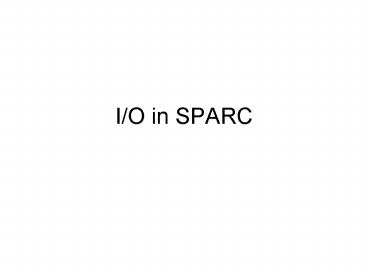IO in SPARC - PowerPoint PPT Presentation
1 / 13
Title:
IO in SPARC
Description:
o0 must be containing the address of a null terminated string (c-string). A null terminated string is a string ended with 1 byte zero. For example: !in your data ... – PowerPoint PPT presentation
Number of Views:57
Avg rating:3.0/5.0
Title: IO in SPARC
1
I/O in SPARC
2
- In SPARC, using system call printf and scanf is
an easy way to perform I/O - These functions perform conversion and extraction
automatically.
3
printf
- To use printf function, the following must be
satisfied - o0 must be containing the address of a null
terminated string (c-string). A null terminated
string is a string ended with 1 byte zero. - For example
- !in your data section
- myString .asciz hello world!
- . . .
- !in your code
- set myString, o0 ! Get the address
of the label - call printf !this should print hello world!
- nop
.ascii string Generates the given sequences of
ASCII characters. .asciz string Generates
the given sequences of ASCII characters. This
pseudo-op appends a null (zero) byte to each
string.
4
- In C
- Print(..Hello world)
- Print(Integer d, someInteger)
- To print out variables value
- you must have your register o1-o5 containing
the values to be substituted
5
- In C Printf(its d dollars,amount)
- In SPARC
- !assuming your string declared as follow
- myString .asciz its d dollars
- !In your code
- set myString, o0 ! The address of the string
- mov 20, o1 !substitutes for the first d
- call printf !will print its 20 dollars
6
d or i Decimal signed integer. o Octal
integer. x or X Hex integer. U Unsigned
integer. c Character. s C-String, i.e. null
terminated string. f Double e or E
Double. g or G Double. n Number of characters
written by this printf.
7
- !assuming your string declared as follow
- myString .asciz its d dollars and d cents
- !In your code
- set myString, o0 ! The address of the string
- mov 20, o1 ! substituted for the first d
- mov 5, o2 ! substituted for the second d
- call printf ! Will print its 20
dollars and 5 cents
8
- To print a string, the address of the substituted
string must be in the correspondent register. - For example
- !assuming your strings are in data section as
follows - mystring .asciz Hello s!
- name .asciz Michael
- . . .
- ! and your code should be
- set myString, o0 ! address of the output
- set name, o1 ! Address of the substituted string
- call printf ! Will print Hello Michael!
- nop
9
scanf
- scanf is used for reading user input
- scanf requires o0 containing the address of a
c-string containing the input format - Subsequence registers (o1-o5) contain the
address of the memory where the input should be
stored - d and i always give you a 32-bit (word-size)
input, so the address must be aligned by word
boundary (aligned by 4)
10
- d or i Decimal signed integer.
- o Octal integer.
- x or X Hex integer.
- U Unsigned integer.
- c Character.
- s C-String, i.e. null terminated string.
- f Double
- e or E Double.
- g or G Double.
- n Number of characters written by this printf.
11
- !assuming your strings are in data section as
follows - input .word 0 !aligned by 4
- format .asciz d
- . . .
- ! and your code should be
- set format, o0 ! Address of the format
- set input, o1 ! Address of the location for the
input - call scanf ! Reads user input, converts to a
- nop ! number and stores at the memory !
referenced by input
12
- !assuming your strings are in data section as
follows - input .word 0 !aligned by 4
- nl .byte 0 ! A byte to store the input \n
- format .asciz dc
- . . .
- ! and your code should be
- set format, o0 ! Address of the format
- set input, o1 ! Address of the location for the
input - set nl , o2 ! location for a character
- call scanf ! Reads user input, converts to a
- nop ! number and stores at the memory !
referenced by input
13
- !assuming your strings are in data section as
follows - format .asciz s
- input .asciz !Allocate
some space for the input string - . . .
- ! and your code should be
- set format, o0 ! Address of the format
- set input, o1 ! Address of the location
for the input - call scanf ! Reads user input
up to a blank or ENTER key - nop































